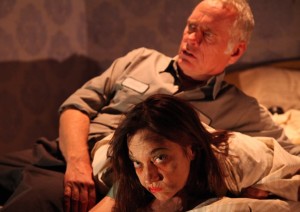Salesgirl revels in absurdity
Biff, Happy and Willy Loman are nowhere to be found in Death of a Salesgirl, a new play presented by the Bootleg Theater.
As the program boasts, “Bootleg Theater is a space for art.” Since its establishment in 2000, the theater has been committed to creating “brave, boundary-pushing, artistically outstanding and highly collaborative new work.”

Where’s Willy?· Despite its title, Death of a Salesgirl has little in common with the Arthur Miller play. With it’s very absurdist approach, Salesgirl makes for one strange but enjoyable theater-going experience. – | Photo courtesy of Justin Zsebe
Thankfully, the Bootleg Theater has succeeded in this endeavor with Salesgirl.
The space itself is a work of art. Walking into the Bootleg is like walking into a well-filtered Instagram picture. The small, dark lobby gives way to a high-ceilinged warehouse, with a small stage for musical acts on one side and a bar on the other. This area functions as a music venue some nights and as a holding pen for theatergoers others. Industrial sculptures of giant orange tubes and Edison bulbs hang over the heads of attendees. Five minutes before curtain, a metal door swings open and audience members are ushered into the theater (and you can bring your drinks inside!), which actually used to be a bra factory.
The set consists of three walls of a standard hotel room, free of any forced perspective tricks. The walls are bare except for two empty, wooden frames, but the moment the show begins, they become canvases for nonstop projections.
Animation by Dan Lund and other projections by Adam Flemming provide a running reflection of the characters’ actions and emotions during the play. In some scenes, the walls are merely covered in a drab wallpaper pattern, with the frames surrounding stunning animations of birds being conjured in and out of thin air. In others, videos of sprinting actors are projected behind the live actors, and the actors even interact with the projections.
If Death of a Salesgirl has a plot, it is indecipherable. A lot happens in this play, but the way in which the events are related is completely mysterious. Here are the facts: Cat, played by a highly energetic Patricia Scanlon, is a traveling saleswoman who has seen little success lately.
“Sales aren’t what they used to be,” she says over and over.
As she prepares herself for what she hopes will be a “very big day” for her career, the manager of the hotel visits her and warns her not to damage the room. Once he leaves, another man, Frank (Paul Dillon), enters and proceeds to destroy the room over the course of the play.
This play is advertised as a dramedy, and for the first ten minutes, that’s what it is. Scanlon, dressed in a traditional trench coat, enters into a noir soundscape with black and white projections of lightning on the walls. She addresses the audience while drawing ridiculous eyebrows on herself with the intensity of Norma Desmond, explaining that she has just completed a course in “conversational reality.” Once she enters the sphere of the hotel room, she removes her trench coat to reveal a green Girl Scout uniform, complete with dozens of patches and brass pins (the first real hint that this show is about to depart from realism).
As soon as Frank bursts through Cat’s door, the madness really begins. First of all, Frank and Cat’s relationship is murky — are they married? Siblings? Father and daughter? — and is never fully explained. The two of them engage in hardcore emotional and physical combat over the most bizarre little things: When Frank can’t find his lucky rabbit foot or Cat refuses to have a drink with him, they end up chasing each other around the room. In addition, Cat spends half the show worrying over the state of her “samples,” two suitcases full of foot-long blue and white rectangular boxes, and doesn’t mention what they contain until the last five minutes — and even then, it’s not entirely clear what she’s selling. Things get especially weird when densely leafed vines crawl over the corners of the set and through the chest of drawers into the room, taking over the scene but garnering no response from the actors.
Even if absurdist theater isn’t exactly your cup of tea, this play is worth seeing just for the opportunity to watch Scanlon do her thing. She plays Cat with a sort of manic intensity that is both heartbreaking and a little unsettling to watch. Her physical commitment to the character is arresting: She is fearless, extremely versatile and looks like she could be anywhere between 30 and 70 years old.
Ultimately, as is the case with other forms of abstract art, different pieces will resonate with different viewers. Death of a Salesgirl jumps between outrageously funny and nearly sickening to watch in a snap, but it will keep your rapt attention for all 70 minutes. Even if you walk out feeling completely confused, there is no way you’ll forget the experience of seeing this play.
